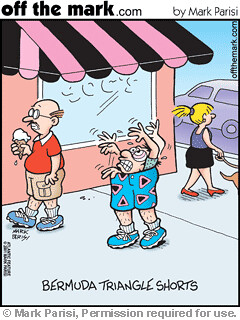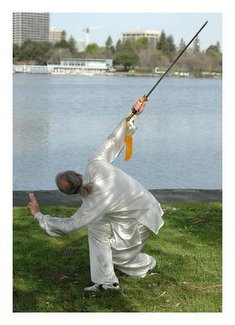Cross posted @ God Is 4 Suckers!
I guess you've heard about the Bermuda triangle
There's something going on
Nobody seems to know just what it is
And the air force won't let on
It might be hole down in the ocean
Yeah or a fog that won't let go
It might be some crazy people talking
Or somebody that we ought to know
Down in Bermuda, the pale blue sea
Way down in the triangle, it's easy to believe – Fleetwood Mac, Bermuda Triangle
Few things capture the public’s imagination like disappearances. We see the occasional child on the back of a milk carton, sometimes a billboard where someone has simply vanished and the frantic efforts of the family to find the vanishee, we hear anecdotal tales where somebody simply wasn’t there suddenly, and of course tales abound of mysterious freighters whose crews seemed to have blinked out of existence. But of all the wild tales, the famous Bermuda Triangle has spawned a series of books and movies, and anyone American instantly recognizes the phrase and its implications.
As I am fond of repeating, everything on earth has a rational, logical explanation. Everything. Five minutes on Wikipedia usually tends to thrash the wild rumors:
The Bermuda Triangle, also known as the Devil's Triangle, is a region in the western part of the North Atlantic Ocean where a number of aircraft and surface vessels allegedly disappeared mysteriously. Popular culture has attributed these disappearances to the paranormal or activity by extraterrestrial beings. Documented evidence indicates that a significant percentage of the incidents were inaccurately reported or embellished by later authors, and numerous official agencies have stated that the number and nature of disappearances in the region is similar to that in any other area of ocean.
Naturally, the true ‘believers’ will concoct some conspiracy theory or whatnot. Or say you need to ‘read between the lines’, or start rattling off ‘facts and figures’ that are demographic to that specific area without comparing to any similar areas or statistics.
The boundaries of the triangle cover the Straits of Florida, the Bahamas and the entire Caribbean island area and the Atlantic east to the Azores. The more familiar triangular boundary in most written works has as its points somewhere on the Atlantic coast of Miami, San Juan, Puerto Rico; and the mid-Atlantic island of Bermuda, with most of the accidents concentrated along the southern boundary around the Bahamas and the Florida Straits.
The area is one of the most heavily traveled shipping lanes in the world, with ships crossing through it daily for ports in the Americas, Europe, and the Caribbean Islands. Cruise ships are also plentiful, and pleasure craft regularly go back and forth between Florida and the islands. It is also a heavily flown route for commercial and private aircraft heading towards Florida, the Caribbean, and South America from points north.
With that density of transport going on, of course there’s going to be ‘disappearances’, or lost ships/planes. It’s just numbers.
The earliest allegation of unusual disappearances in the Bermuda area appeared in a September 16, 1950 Associated Press article by E.V.W. Jones. Two years later, Fate magazine published "Sea Mystery At Our Back Door", a short article by George X. Sand covering the loss of several planes and ships, including the loss of Flight 19, a group of five U.S. Navy TBM Avenger bombers on a training mission. Sand's article was the first to lay out the now-familiar triangular area where the losses took place. Flight 19 alone would be covered in the April 1962 issue of American Legion Magazine. It was claimed that the flight leader had been heard saying "We are entering white water, nothing seems right. We don't know where we are, the water is green, no white." It was also claimed that officials at the Navy board of inquiry stated that the planes "flew off to Mars." Sand's article was the first to suggest a supernatural element to the Flight 19 incident. In the February 1964 issue of Argosy, Vincent Gaddis's article "The Deadly Bermuda Triangle" argued that Flight 19 and other disappearances were part of a pattern of strange events in the region. The next year, Gaddis expanded this article into a book, Invisible Horizons.
Ah, excuse me: Fate? The handbook of the delusional? And Argosy is a boy’s adventure pulp magazine, specializing in fiction.
Others would follow with their own works, elaborating on Gaddis's ideas: John Wallace Spencer (Limbo of the Lost, 1969, repr. 1973); Charles Berlitz (The Bermuda Triangle, 1974); Richard Winer (The Devil's Triangle, 1974), and many others, all keeping to some of the same supernatural elements outlined by Eckert.
All of which are out of print.
Luckily, there was someone about who actually had a critical eye:
Lawrence David Kusche, a research librarian from Arizona State University and author of The Bermuda Triangle Mystery: Solved (1975) argued that many claims of Gaddis and subsequent writers were often exaggerated, dubious or unverifiable. Kusche's research revealed a number of inaccuracies and inconsistencies between Berlitz's accounts and statements from eyewitnesses, participants, and others involved in the initial incidents. Kusche noted cases where pertinent information went unreported, such as the disappearance of round-the-world yachtsman Donald Crowhurst, which Berlitz had presented as a mystery, despite clear evidence to the contrary. Another example was the ore-carrier recounted by Berlitz as lost without trace three days out of an Atlantic port when it had been lost three days out of a port with the same name in the Pacific Ocean. Kusche also argued that a large percentage of the incidents that sparked allegations of the Triangle's mysterious influence actually occurred well outside it. Often his research was simple: he would review period newspapers of the dates of reported incidents and find reports on possibly relevant events like unusual weather, that were never mentioned in the disappearance stories.
Kusche concluded that:
- The number of ships and aircraft reported missing in the area was not significantly greater, proportionally speaking, than in any other part of the ocean.
- In an area frequented by tropical storms, the number of disappearances that did occur were, for the most part, neither disproportionate, unlikely, nor mysterious; furthermore, Berlitz and other writers would often fail to mention such storms.
- The numbers themselves had been exaggerated by sloppy research. A boat's disappearance, for example, would be reported, but its eventual (if belated) return to port may not have been.
- Some disappearances had, in fact, never happened. One plane crash was said to have taken place in 1937 off Daytona Beach, Florida, in front of hundreds of witnesses; a check of the local papers revealed nothing.
- The legend of the Bermuda Triangle is a manufactured mystery, perpetuated by writers who either purposely or unknowingly made use of misconceptions, faulty reasoning, and sensationalism.
And further:
When the UK Channel 4 television program "The Bermuda Triangle" (c. 1992) was being produced by John Simmons of Geofilms for the Equinox series, the marine insurer Lloyd's of London was asked if an unusually large number of ships had sunk in the Bermuda Triangle area. Lloyd's of London determined that large numbers of ships had not sunk there.
Yeah…none of the ‘true believers’ thought to ask a major insurer? What a surprise.
United States Coast Guard records confirm their conclusion. In fact, the number of supposed disappearances is relatively insignificant considering the number of ships and aircraft that pass through on a regular basis.
Do I need to repeat it? Numbers.
The Coast Guard is also officially skeptical of the Triangle, noting that they collect and publish, through their inquiries, much documentation contradicting many of the incidents written about by the Triangle authors. In one such incident involving the 1972 explosion and sinking of the tanker SS V. A. Fogg in the Gulf of Mexico, the Coast Guard photographed the wreck and recovered several bodies, in contrast with one Triangle author's claim that all the bodies had vanished, with the exception of the captain, who was found sitting in his cabin at his desk, clutching a coffee cup.
That one sounds vaguely familiar, probably from the days I read Fort.
The NOVA/Horizon episode The Case of the Bermuda Triangle, aired on June 27, 1976, was highly critical, stating that "When we've gone back to the original sources or the people involved, the mystery evaporates. Science does not have to answer questions about the Triangle because those questions are not valid in the first place... Ships and planes behave in the Triangle the same way they behave everywhere else in the world."
I’m stealing that line about ‘science doesn’t have to answer questions’, because it fits so well for so many debunkings. The following paragraph will no doubt sound familiar:
David Kusche pointed out a common problem with many of the Bermuda Triangle stories and theories: "Say I claim that a parrot has been kidnapped to teach aliens human language and I challenge you to prove that is not true. You can even use Einstein's Theory of Relativity if you like. There is simply no way to prove such a claim untrue. The burden of proof should be on the people who make these statements, to show where they got their information from, to see if their conclusions and interpretations are valid, and if they have left anything out."
And the following is Sad But True, #2:
Skeptical researchers, such as Ernest Taves and Barry Singer, have noted how mysteries and the paranormal are very popular and profitable. This has led to the production of vast amounts of material on topics such as the Bermuda Triangle. They were able to show that some of the pro-paranormal material is often misleading or inaccurate, but its producers continue to market it. Accordingly, they have claimed that the market is biased in favor of books, TV specials, and other media that support the Triangle mystery, and against well-researched material if it espouses a skeptical viewpoint.
No surprise there. SIGH.
Finally, if the Triangle is assumed to cross land, such as parts of Puerto Rico, the Bahamas, or Bermuda itself, there is no evidence for the disappearance of any land-based vehicles or persons. The city of Freeport, located inside the Triangle, operates a major shipyard and an airport that handles 50,000 flights annually and is visited by over a million tourists a year.
Wow. Has any of these pro-Triangle folk interviewed any inhabitants of Freeport, and checked for weird stories? I’d bet the rent on NO.
One of my all time favorites about this ‘mysterious patch of ocean’, is the famous ‘compass gone crazy’ crap:
Compass problems are one of the cited phrases in many Triangle incidents. While some have theorized that unusual local magnetic anomalies may exist in the area, such anomalies have not been shown to exist. Compasses have natural magnetic variations in relation to the magnetic poles, a fact which navigators have known for centuries. Magnetic (compass) north and geographic (true) north are only exactly the same for a small number of places - for example, as of 2000 in the United States only those places on a line running from Wisconsin to the Gulf of Mexico. But the public may not be as informed, and think there is something mysterious about a compass "changing" across an area as large as the Triangle, which it naturally will.
As was mentioned earlier, this is one of the heaviest travelled shipping lanes in the world. If compasses didn’t work there, logic would dictate it would be one of the least travelled shipping lanes, not vice versa.
So, in conclusion: if you’re planning a trip to Bermuda, it’s perfectly safe, no matter what fish story you may have heard.














No comments:
Post a Comment